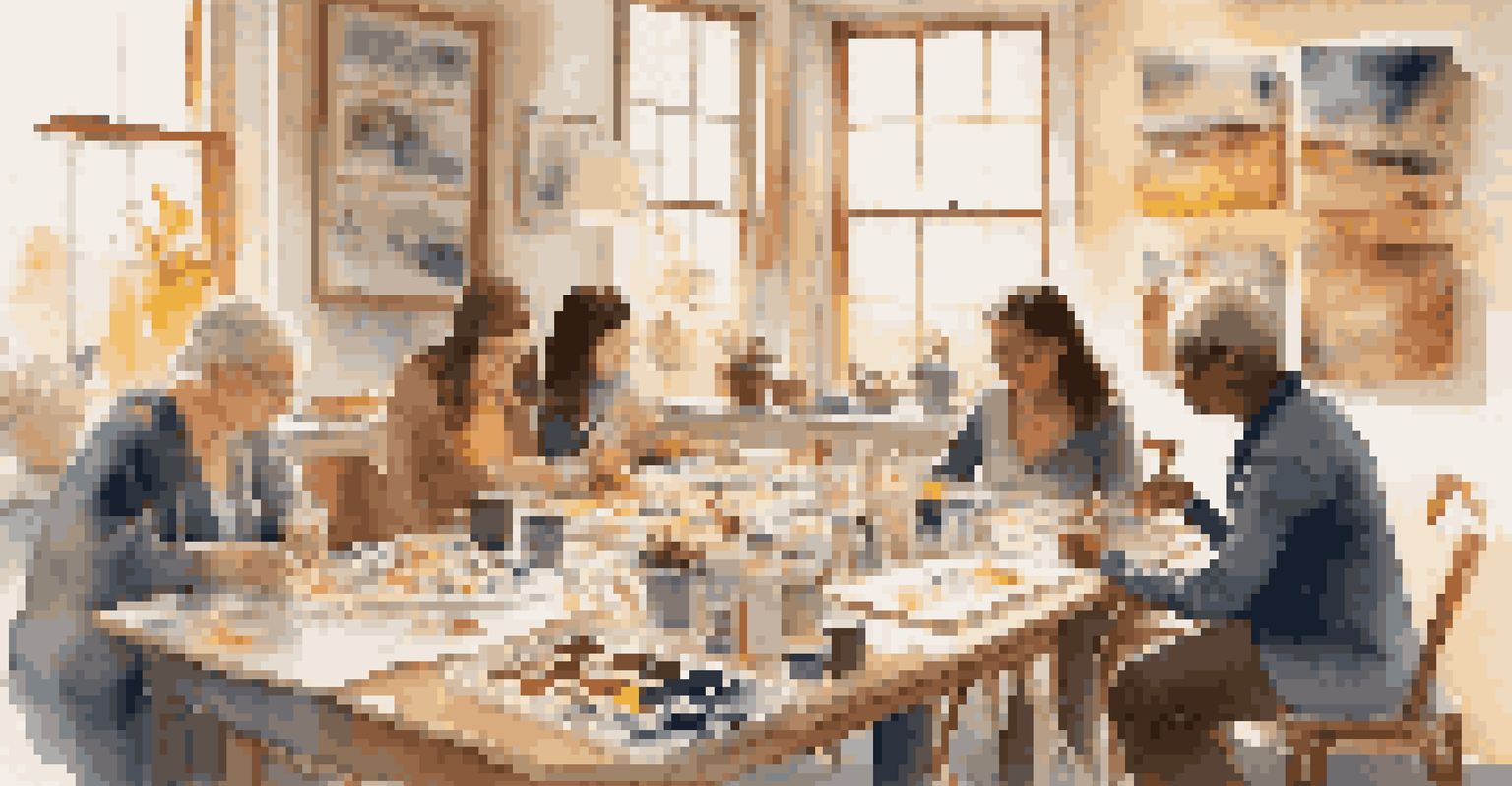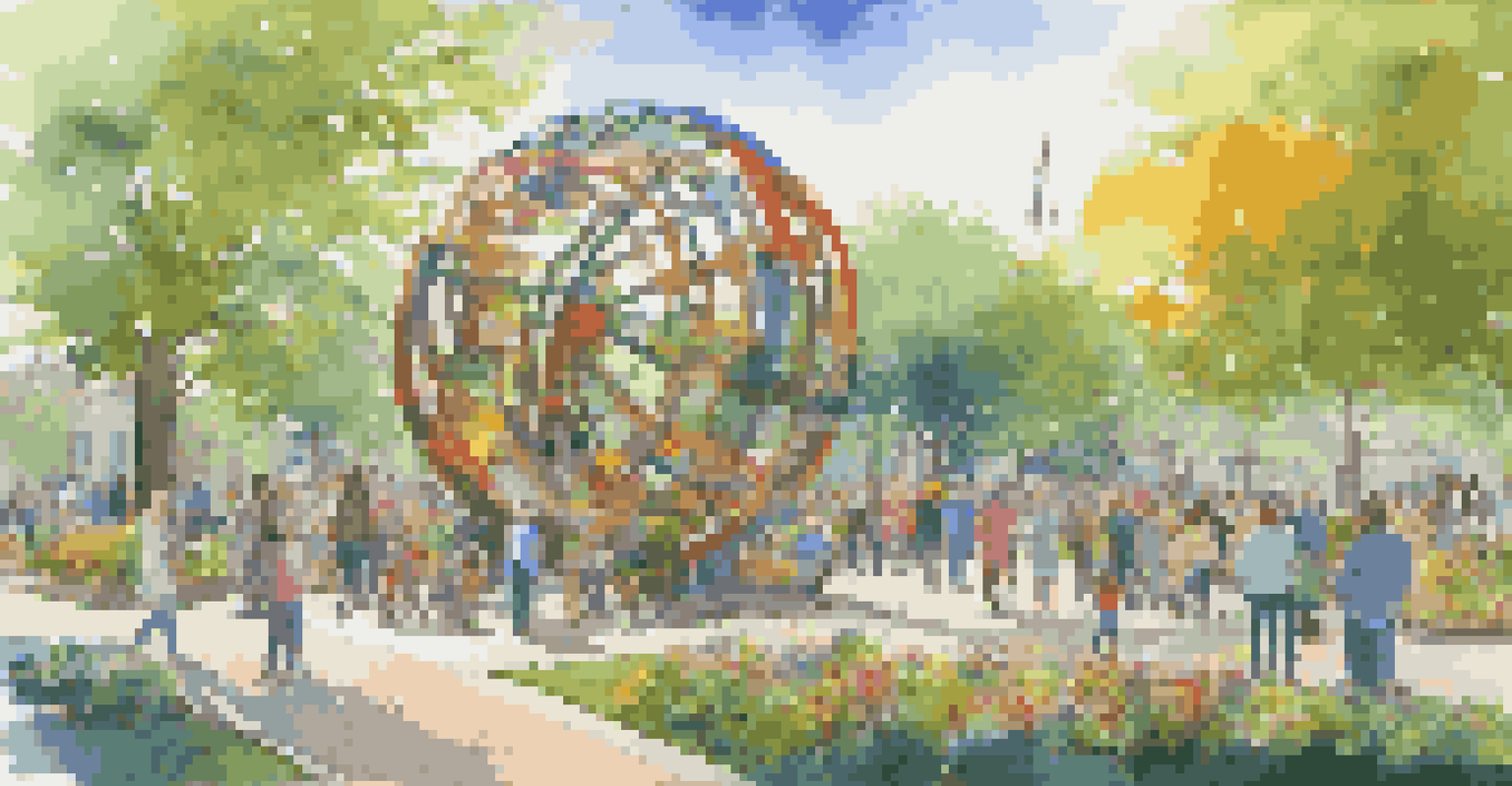Art and Community Resilience: A Path to Healing

Understanding Community Resilience Through Art
Community resilience refers to the ability of a group to recover from adversity. Art plays a crucial role in this process by providing a platform for expression and connection. When people come together to create or appreciate art, they build a sense of belonging that can help them heal.
Art is the most beautiful of all lies; it is a lie that tells the truth about our lives.
In times of crisis, whether due to natural disasters or social unrest, art offers a way to process emotions and experiences. For instance, murals painted after a tragedy can serve as powerful reminders of hope and solidarity. This shared creative experience strengthens the bonds within the community.
Moreover, art can reflect the unique stories of a community, showcasing its culture and history. By celebrating these narratives through artistic expression, communities can foster pride and resilience, making them more prepared to face future challenges.
The Role of Art in Healing Trauma
Art therapy has gained recognition as an effective means of healing trauma. By allowing individuals to express their feelings creatively, art becomes a therapeutic outlet. This method can help people process their emotions without the need for words, which can be especially beneficial for those who struggle to articulate their pain.

For example, a community that has experienced loss may host art workshops where participants create pieces that represent their grief. This shared activity not only facilitates healing but also builds a supportive network among participants. The act of creating together reinforces the idea that they are not alone in their experiences.
Art Builds Community Resilience
Art fosters a sense of belonging and connection, allowing communities to heal from adversity.
Additionally, engaging in artistic activities can lead to increased self-esteem and empowerment. When individuals see their creations valued by others, it boosts their confidence and encourages further participation in community life. This cycle of creation and recognition fosters a resilient spirit.
Art as a Catalyst for Social Change
Art has historically been a powerful tool for social change, amplifying voices and messages that may otherwise go unheard. Through various forms of artistic expression—such as music, theater, and visual arts—communities can highlight issues that affect them. This not only raises awareness but also inspires action and solidarity.
Creativity is the antidote to destruction. It brings people together, heals wounds, and builds communities.
For instance, street art often comments on social and political issues, engaging the public in conversations that matter. These visual narratives can motivate individuals to advocate for change, creating a sense of purpose within the community. When art serves as a vehicle for social commentary, it can unify people toward a common goal.
Moreover, collective art projects can invite diverse perspectives, ensuring that all voices are heard. This inclusivity fosters resilience, as communities learn to embrace their differences and work together towards solutions. The result is a stronger, more cohesive society that can withstand adversity.
Case Studies of Artistic Resilience
Examining real-world examples can provide insight into how art fosters resilience in communities. After Hurricane Katrina devastated New Orleans, artists came together to create works that reflected their experiences and hopes. These pieces not only served as a form of healing but also attracted attention and support for the city’s recovery.
Similarly, in places affected by conflict, such as Syria, artists have used their craft to share stories of survival and resistance. These narratives resonate deeply, allowing people to connect emotionally and advocate for peace. Through art, communities can reclaim their narratives and foster a sense of agency.
Art as a Healing Tool
Engaging in art therapy helps individuals process trauma and strengthens community support networks.
These case studies illustrate that art is not just a response to adversity; it is a proactive tool for building resilience. By investing in artistic initiatives, communities can empower their members and create spaces for healing and growth.
Engaging Youth Through Artistic Initiatives
Engaging young people in artistic initiatives is vital for nurturing future resilience. When youth are given the opportunity to express themselves creatively, they develop crucial skills such as teamwork, communication, and critical thinking. These experiences can shape their identities and strengthen their ties to the community.
For instance, after-school art programs can offer a safe space for youth to explore their creativity while addressing issues relevant to their lives. By participating in these programs, young individuals learn to articulate their thoughts and feelings, fostering emotional intelligence and resilience.
Moreover, involving youth in community art projects cultivates a sense of ownership and pride. When they see their contributions valued, it enhances their commitment to the community. This investment in the next generation ensures that the spirit of resilience continues to thrive.
The Impact of Public Art on Community Healing
Public art installations can serve as powerful symbols of hope and healing within a community. These works often invite interaction and engagement, creating shared experiences that foster connection among residents. Whether it’s a sculpture in a park or a mural on a building, public art has the ability to transform spaces and uplift spirits.
For example, a community that has suffered loss may commission a public memorial that honors those affected. Such installations not only provide a place for reflection but also remind residents of their shared history. The process of creating and unveiling public art can unite a community around a common purpose.
Youth Engagement is Crucial
Involving young people in artistic initiatives cultivates essential skills and ensures future community resilience.
Public art also encourages dialogue and collaboration among diverse groups. When community members come together to plan and execute an art project, they build relationships that can lead to greater understanding and resilience. This collaborative spirit is crucial for thriving communities.
Building a Sustainable Arts Ecosystem
Creating a sustainable arts ecosystem is essential for ongoing community resilience. This involves not only supporting local artists but also fostering spaces where creativity can flourish. By investing in arts education, funding, and resources, communities can ensure that artistic expression remains a vibrant part of their identity.
Partnerships between local governments, businesses, and artists can also play a significant role in sustaining arts initiatives. For instance, local businesses can sponsor art events or provide spaces for exhibitions, creating a mutually beneficial relationship. This support encourages a thriving arts culture that contributes to community resilience.

Moreover, promoting accessibility to the arts ensures that all community members can participate and benefit. By offering free or low-cost programs, communities can break down barriers, allowing diverse voices to be heard. A robust arts ecosystem not only enhances resilience but also enriches the community’s cultural fabric.